Enhancing English Vocabulary with LEGO
Ulla Kaad Krogsgaard, Denmark
Ulla K. Krogsgaard is an educational advisor at the University College Absalon, Educational Ressource Center. Her area of expertise is foreign languages, esp. English, as well as internationalization in schools. She is particularly interested in methodology and didactics for early English learning. She has been a teacher in the Danish primary school for nearly 30 years and is now among many other things working with teachers as regards pre-service and in-service training. Ulla Krogsgaard also tries out new ideas in schools, for example by making LEGO workshops for 10-12-year-olds. E-mail: ukr@pha.dk

Menu
Introduction
What is Lego StoryStarter?
What is a fairy tale ‘mash up’?
Goals and objectives
Pre-building scaffolding activities to choose from
Prepare a ‘mash-up’ fairy tale
Building a ‘mash-up
Photos
Writing process
Presentation
The process in short
References
Communicative language learning requires vocabulary and chunks to be successful. When communication in the classroom or in real life breaks down it very seldom is due to pronunciation errors or grammar mistakes, whereas the lack of vocabulary often can lead to language problems. As a teacher, it is important to have knowledge about language processes as well as how to deal with vocabulary in praxis. What works? What motivates the student?
That Lego Story Starter can be an effective didactical tool is a claim supported by academic studies about teaching with artefacts.
Professor Arthur Glenburg fx did a research paper in 2007 where he compared different groups of second/third graders who were to read the same texts. One group read the story and reconstructed sentences using adequate toys. The groups using artefacts were able to sum up the contents, had a better understanding and remembered text and details for a longer period than the groups who read the story twice without the use of artefacts.
I.e. the more senses are used the more effectively students understand and store information. This is not new knowledge, but is worth remembering.
In this article, I will describe ideas for working with Lego Story Starter (or plain Lego bricks) that accommodate vocabulary acquisition as well as oral and written communication.
Lego StoryStarter is a functional innovative tool to work with narratives, articles, reports etc. The students literally build their stories with Lego bricks, subsequently they make the narrative come to live digitally (iPad or PC) with the free programme Bookcreator: https://app.bookcreator.com/books
StoryStarter is simply a box of Lego Bricks with 6 plates. StoryStarter is not produced anymore, but you can easily use your own bricks and plates. It’s a good idea to start your own classroom collection of Lego bricks.
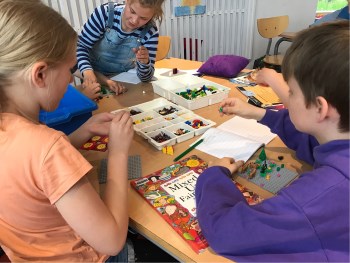
The students mix 2-3 well known fairy tales and create a completely new version with a new title. Fx Snow White and Grandmother’s 12 Little Ducklings.
See examples made by English students http://greenscreenadventures.tv/the-mixed-up-fairy-t/
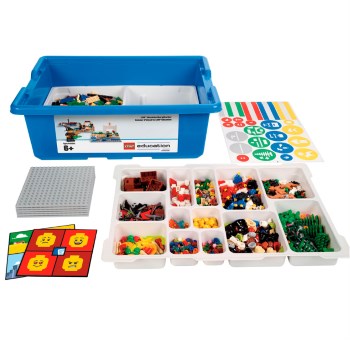
In this example, mash up faire tales is the topic for Danish 5th graders (11 year olds in their third year of learning English). To ensure that the process with the Lego bricks is successful, the topic need to be started two to four weeks before the actual story building to activate pre-knowledge of the genre and to build up vocabulary.
The objectives for the topic are as follows:
- The students know at least five different fairy tales in English
- The students know idioms to begin and end a fairy tale
- The students know at least five different features that characterise the genre
- The students can build a mash up fairy tale with Lego Story Starter (or just Lego bricks), they can tell the story and write it in the app BookCreator (chrome browser: https://app.bookcreator.com/books) using at least 10 new words
- The students can present their product in English
- Find out which fairy tales already are familiar in English to the students. This may be done on paper or using the digital wall www.padlet.com. Write the title in English and mother tongue and look at semantic similarities in the languages to create awareness.
- Read different tales individually, in pairs or in class.
- Upload an extract of a fairy tale to the interactive board and print out a copy for everybody. Together you mark one or two categories from below:
- Vocabulary characterising the genre
- Vocabulary that describe characters of the tale
- Vocabulary from nature
- Different chunks, like ‘once upon a time’
- Adjectives
- Verbs
- Etc.
Now hand out a clean copy (or a similar text extract) and ask the students to do the same in pairs.
The students then exchange the vocabulary categories with their own words and create a different text. This may be done several times.
- Work with story starters and story endings. Ask the students to write a small piece of text, e.g. three different beginnings of a fairy tale (each bit no longer than 4-5 lines). Hang them on the wall and ask the students to walk around and give feedback e.g. from the following criteria:
- Does the headline indicate this is a fairy tale?
- Are the important words in the headline spelled with capital letters?
- Does this introduction make me want to read more?
This technique can be used in the same way with endings, characteristics, description of environment etc.
- Make a dating site. The students write advertisements using fairy tale vocabulary and content, e.g. ‘Witch seeks future husband with quiet, soft and tender children.’
- All the students read the advertisements and answer some of them
- Organize speed dating - anybody pairing up?
During this pre-building phase, it is important to work very explicitly with vocabulary and recycle the words many times. This is important for the students in order to pass the line from recognising a word to actually being able to use it orally and in writing.
Before starting the building process the students can prepare their mash up by writing vocabulary and chunks in a table like the one below. A ‘must have’ would be ‘write at least 10 words you didn’t know before’, and/or give a list of words that must be used in the story.

Make sure you have a lot of Lego bricks and plates in the classroom.
The building process takes place in groups of 2-3 students. Every group has 3 plates and a lot of different Lego bricks on the table.
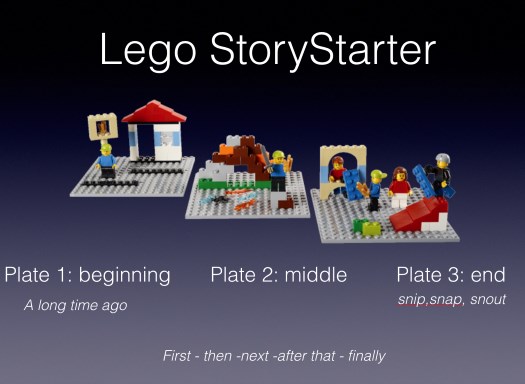
Every plate has a function:
Plate 1: Build the introduction e.g. Once upon a time there was a dwarf
Plate 2: Build the main part of the story
Plate 3: Build the end: …and they lived happily ever after
In this way, the story of the structure becomes very clear and concrete. The students build their prepared tale. Whenever a plate has been built the students tell the part in English to their peers or the teacher. During the process vocabulary is looked up, notes taken, ideas negotiated and the language revised. When the group is satisfied with the tale they have, they tell the whole story to a teacher.
Now the students can take photos of their Lego tales. It’s easiest to use an iPad, but they can use their phones or a digital camera as well. The students take many pictures of their three plates.
They use the free program https://app.bookcreator.com/books for PC or the app BookCreator for iPad. It’s a very easy and intuitive program to use. First, you choose templates and format and then you create the front page. The students make a digital book and upload pictures of the Lego plates to tell their story.
Next step is to activate the students’ written language. The new vocabulary has now been recycled repeatedly, so it is a good time to start the writing process. This can be done in many levels. Speaking bubbles can be inserted for direct speech, or narrative language may be added which gives an opportunity to use the past tense – thus, there are good possibilities for differentiating and working with forms.
During the process, peer feedback or teacher/student feedback is given, and the text is revised.
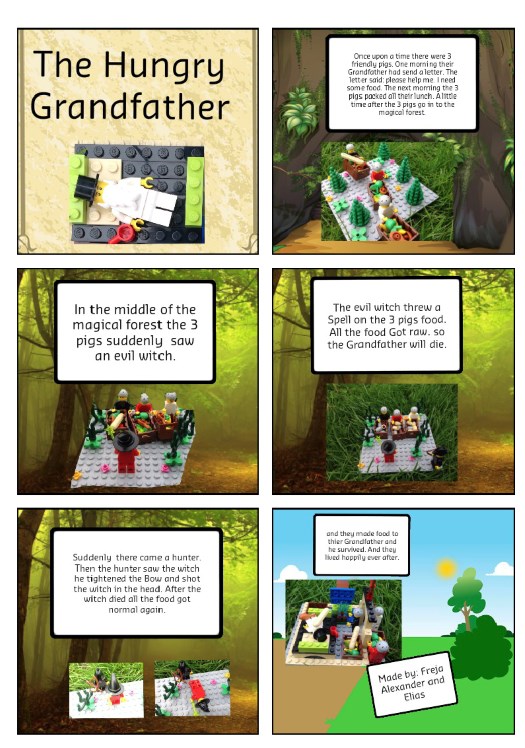
The topic Mash up fairy tales – building with Lego is not finished until all groups have made a presentation of their new fairy tale on the interactive board. The audience could be the class, the neighbour class, parents etc. In this way, the communication and outcome of the process is authentic, which motivates the student to make a great effort. This also provides good opportunities for evaluation of every book (story). Of course, the presentation needs to be well prepared, every student in the group must present an equal share, and the 10 new words as well as all set criteria need to be integrated. Maybe the students have practised good intonation, which makes listening extra worthwhile. Some students need the support of the digital book, others can tell the story fairly independently. Again, the method offers differentiation possibilities.
BookCreator offers the possibility of recording the story or inserting sounds, which can be very thrilling.
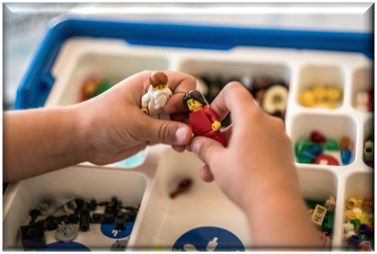
Afterwards you can print the tale, create a library within the program, share a link on the school’s website, or even publish the ‘book’ worldwide within the program BookCreator.
- Group members agree on fairy tales to mash up
- Look up vocabulary, write notes and part of the story on paper
- Build on three plates (intro, main part, end)
- Tell the tale to another group
- Revise, make notes
- Take digital pictures
- Uploade in BookCreator
- Write (or record) the tale
- Receive feedback from peer/teacher
- Revise
- Receive feedback from peer/teacher
- Last revision
- Practise presentation
- Present for the class, parents, and/or younger/older class
- Evaluation
Birgit Henriksen: Ord og tekst Undervisningsministeriet 2000
Hartberg et al.: Feedback i skolen, Dafolo 2012
Hanne Leth m.fl.: Fagdidaktik i sprogfag, Frydenlund 2015
Jette Aas, Alle har en historie at bygge , fra Sprogforum nr. 59, 2014
Arthur Glenberg, Activity and Imagined Activity Can Enhance Young Children’s Reading Comprehension, Journal of Educational Psychology 2004, vol. 3
Kjeld Fredens http://www.skoven-i-skolen.dk/content/n%C3%A5r-tingene-taler-til-os

Please check the Creative Methodology for the Classroom course at Pilgrims website.
Please check the Methodology and Language for Kindergarten course at Pilgrims website.
Please check the Methodology and Language for Primary course at Pilgrims website.


|